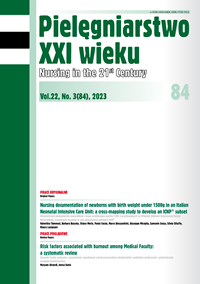Nowe technologie wykorzystywane w kształceniu pielęgniarek i położnych
DOI:
https://doi.org/10.2478/pielxxiw-2023-0026Słowa kluczowe:
praktyka kliniczna, edukacja, położna, pielęgniarka, technologiaAbstrakt
NOWE TECHNOLOGIE WYKORZYSTYWANE W KSZTAŁCENIU PIELĘGNIAREK I POŁOŻNYCH
Wprowadzenie. Edukacja pielęgniarska ewaluowała od tradycyjnych modeli do metod wykorzystujących technologię do pozyskiwania wiedzy, zmierzając w kierunku uczenia się, nauczania i oceniania zorientowanego na studenta.
Cel pracy. Celem pracy jest analiza piśmiennictwa na temat wykorzystania nowoczesnych technologii w edukacji pielęgniarskiej i położniczej.
Materiał i metody. Dokonano krytycznej analizy piśmiennictwa naukowego. Przeszukano bazy danych: PubMed, CINAHL® Complete, Web of Science za pomocą kombinacji słów kluczowych: mobile technologies, nursing, midwife, education, clinical education, apps.
Wnioski. W literaturze istnieją różne przykłady innowacyjnych modeli nauczania i uczenia się w zakresie kształcenia pielęgniarek i położnych. Metody te polegają na łączeniu tradycyjnego nauczania z wykorzystaniem innowacyjnych technologii, takich jak symulacja, e-learning, wirtualne środowiska edukacyjne, korzystanie z mediów społecznościowych czy aplikacji na urządzeniach mobilnych typu smartfon/tablet. Szybko postępujący rozwój technologiczny oraz zmiana oczekiwań współczesnych studentów wymusza konieczność oferowania usług edukacyjnych zawierających większą ilość mediów wizualnych, dostarczania informacji zwrotnych, tworzenia środowisk pozwalających studentom rozwijać własne podejście do przyswajania wiedzy i umiejętności. Uczenie się za pośrednictwem smartfona można uznać za skuteczną metodę uzupełniającą dostarczania materiałów edukacyjnych studentom pielęgniarstwa i położnictwa w celu zwiększenia ich umiejętności.
Bibliografia
1. Vogt M, Schaff ner B, Ribar A, et al. The impact of podcasting on the learning and satisfaction of undergraduate nursing students. Nurse Educ. Pract. 2010; 10(1): 38-42. doi: 10.1016/j.nepr.2009.03.006.
2. Chen B, Yang T, Wang Y, et al. Nursing students’ attitudes toward mobile learning: An integrative review. Int. J. Nurs. Sci. 2021; 8(4): 477-485. doi: 10.1016/j.ijnss.2021.08.004.
3. Stone R, Cooke M, Mitchell M. Undergraduate nursing students’ use of video technology in developing confi dence in clinical skills for practice: A systematic integrative literature review. Nurse Education Today. 2020; 84: 104230. doi:10.1016/j.nedt.2019.104230.
4. Ho CJ, Chiu WH, Li MZ, et al. The eff ectiveness of the iLearning application on chest tube care education in nursing students. Nurse Educ Today. 2021; 101: 104870. doi: 10.1016/j.nedt.2021.104870.
5. Thorell M, Fridorff -Jens PK, Lassen P, et al. Transforming students into digital academics: a challenge at both the individual and the institutional level. BMC Med. Educ. 2015; 15: 48. doi: 10.1186/s12909-015-0330-5.
6. O’Connor S, Chu CH, Thilo F, et al. Professionalism in a digital and mobile world: A way forward for nursing. J. Adv. Nurs. 2020; 76(1): 4-6. doi: 10.1111/jan.14224.
7. Barisone M, Bagnasco A, Aleo G, et al. The eff ectiveness of web-based learning in supporting the development of nursing students’ practical skills during clinical placements: A qualitative study. Nurse Educ. Pract. 2019; 37: 56-61. doi: 10.1016/j.nepr.2019.02.009.
8. Hart T, Bird D, Farmer R. Using blackboard collaborate, a digital web conference tool, tu suport nursing students placement learning: a pilot study exploring its impact. Nurse Educ. Pract. 2019; 38: 72-78. doi: 10.1016/j.nepr.2019.05.009.
9. O’Connor S, Daly CS, MacArthur J, et al. Podcasting in nursing and midwifery education: An integrative review. Nurse Educ. Pract. 2020; 47: 102827. doi: 10.1016/j.nepr.2020.102827.
10. Männistö M, Mikkonen K, Kuivila HM, et al. Digital collaborative learning in nursing education: a systematic review. Scand. J. Caring Sci. 2020; 34(2): 280-292. doi: 10.1111/scs.12743.
11. Mulyadi M, Tonapa SI, Rompas SSJ, et al. Eff ects of simulation technology-based learning on nursing students’ learning outcomes: A systematic review and metaanalysis of experimental studies. Nurse Educ. Today. 2021; 107: 105127. doi: 10.1016/j.nedt.2021.105127.
12. Jang S, Suh EE. Development and application of a mobile-based multimedia nursing competency evaluation system for nursing students: A mixed-method randomized controlled study. Nurse Education in Practice 2022; 64: 103458. https://doi.org/10.1016/j.nepr.2022.103458.
13. Zarandona J, Cariñanos-Ayala S, Cristóbal-Domínguez E, et. al. With a smartphone in one’s pocket: A descriptive cross-sectional study on smartphone use, distraction and restriction policies in nursing students. Nurse Educ. Today. 2019; 82: 67-73. doi: 10.1016/j.nedt.2019.08.001.
14. Kim JH, Park H. Eff ects of Smartphone-Based Mobile Learning in Nursing Education: A Systematic Review and Meta-analysis. Asian Nurs Res (Korean Soc Nurs Sci). 2019; 13(1): 20-29. doi: 10.1016/j.anr.2019.01.005.
15. Chuang YH, Lai FC, Chang CC, et al. Eff ects of a skill demonstration video delivered by smartphone on facilitating nursing students’ skill competencies and selfconfidence: A randomized controlled trial study. Nurse Educ. Today. 2018; 66: 63-68. doi: 10.1016/j.nedt.2018.03.027.
16. O’Connor S, Andrews T. Smartphones and mobile applications (apps) in clinical nursing education: A student perspective. Nurse Educ. Today. 2018; 69: 172-178. doi: 10.1016/j.nedt.2018.07.013.
17. Strickland HP, Kaylor SK. Bringing your a-game: Educational gaming for student success. Nurse Educ. Today. 2016; 40: 101-103. doi: 10.1016/j.nedt.2016.02.014.
18. O’Connor S, Jolliff e S, Stanmore E, et al. Social media in nursing and midwifery education: A mixed study systematic review. J. Adv. Nurs. 2018; 74(10): 2273-2289. doi: 10.1111/jan.13799.
19. Chang HY, Wu HF, Chang YC, et al. The eff ects of a virtual simulation-based, mobile technology application on nursing students’ learning achievement and cognitive load: Randomized controlled trial. Int. J. Nurs. Stud. 2021; 120: 103948. doi: 10.1016/j.ijnurstu.2021.103948.
20. Choi J, Thompson CE, Choi J, et al. Eff ectiveness of Immersive Virtual Reality in Nursing Education: Systematic Review. Nurse Educ. 2022; 47(3): E57-E61. doi: 10.1097/NNE.0000000000001117.
21. Hao X, Peng X, Ding X, et al. Application of digital education in undergraduate nursing and medical interns during the COVID-19 pandemic: A systematic review. Nurse Educ. Today. 2022; 108: 105183. doi: 10.1016/j.nedt.2021.105183.
22. Hara CYN, Goes FDSN, Camargo RAA, et al. Design and evaluation of a 3D serious game for communication learning in nursing education. Nurse Educ. Today. 2021; 100: 104846. doi: 10.1016/j.nedt.2021.104846.
23. Edwards D, Hawker C, Carrier J, et al. A systematic review of the effectiveness of strategies and interventions to improve the transition from student to newly qualified nurse. Int. J. Nurs. Stud. 2015; 52(7): 1254-1268. doi: 10.1016/j.ijnurstu.2015.03.007.
24. Cummings CL, Connelly LK. Can nursing students’ confidence levels increase with repeated simulation activities? Nurse Educ. Today. 2016; 36: 419-421. doi: 10.1016/j.nedt.2015.11.004.
Pobrania
Opublikowane
Numer
Dział
Licencja
Prawa autorskie (c) 2023 Autorzy

Utwór dostępny jest na licencji Creative Commons Uznanie autorstwa 4.0 Międzynarodowe.




